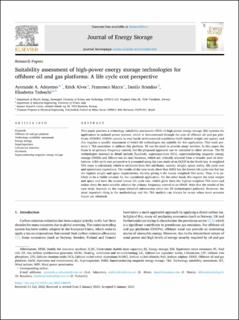| dc.contributor.author | Adeyemo, Ayotunde Adekunle | |
| dc.contributor.author | Alves, Erick Fernando | |
| dc.contributor.author | Marra, Francesco | |
| dc.contributor.author | Iglesias Brandao, Danilo | |
| dc.contributor.author | Tedeschi, Elisabetta | |
| dc.date.accessioned | 2023-12-06T07:08:29Z | |
| dc.date.available | 2023-12-06T07:08:29Z | |
| dc.date.created | 2023-03-01T14:16:29Z | |
| dc.date.issued | 2023 | |
| dc.identifier.issn | 2352-152X | |
| dc.identifier.uri | https://hdl.handle.net/11250/3106127 | |
| dc.description.abstract | This paper presents a technology suitability assessment (TSA) of high-power energy storage (ES) systems for application in isolated power systems, which is demonstrated through the case of offshore oil and gas platforms (OOGPs). OOGPs operate in very harsh environmental conditions (with limited weight and space), and this requires a specific assessment of which ES technologies are suitable for this application. This work presents a TSA procedure to address this problem. ES can be sized to provide many services. In this paper the focus is on primary frequency control, but the proposed approach can be extended to other services. The ES technologies assessed in detail include flywheels, supercapacitors (SCs), superconducting magnetic energy storage (SMES) and lithium-ion (Li-ion) batteries, which are critically selected from a broader pool of alternatives. A life cycle cost perspective is presented using the case study of an OOGP in the North Sea. A weighted TSA score is calculated, which is estimated from five attributes, namely: weight, space, safety, life cycle cost and operational experience. The results of the case study show that SMES has the lowest life cycle cost but has the highest weight and space requirements, thereby giving it the lowest weighted TSA score. Thus, it is unlikely to be a viable solution for the considered application. On the other hand, SCs require the least weight and space and have the second lowest life cycle cost, which gives them the highest weighted TSA score and makes them the most suitable solution for primary frequency control in an OOGP. Note that the results of the case study depends on the inputs (detailed information about the ES technologies) gathered. However, the most important thing is the methodology and the TSA analysis can always be re-run when more accurate inputs are obtained. | en_US |
| dc.language.iso | eng | en_US |
| dc.publisher | Elsevier B. V. | en_US |
| dc.rights | Navngivelse 4.0 Internasjonal | * |
| dc.rights.uri | http://creativecommons.org/licenses/by/4.0/deed.no | * |
| dc.title | Suitability assessment of high-power energy storage technologies for offshore oil and gas platforms: A life cycle cost perspective | en_US |
| dc.title.alternative | Suitability assessment of high-power energy storage technologies for offshore oil and gas platforms: A life cycle cost perspective | en_US |
| dc.type | Peer reviewed | en_US |
| dc.type | Journal article | en_US |
| dc.description.version | publishedVersion | en_US |
| dc.source.volume | 61 | en_US |
| dc.source.journal | Journal of Energy Storage | en_US |
| dc.identifier.doi | 10.1016/j.est.2023.106643 | |
| dc.identifier.cristin | 2130518 | |
| dc.source.articlenumber | 106643 | en_US |
| cristin.ispublished | true | |
| cristin.fulltext | postprint | |
| cristin.fulltext | original | |
| cristin.qualitycode | 1 | |

